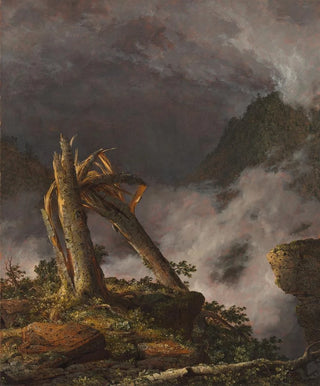Painting Storm in the Mountains - Frederic Edwin Church | Art print


View from behind

Frame (optional)
In the fascinating world of 19th-century landscape art, "Tempête dans les montagnes" by Frederic Edwin Church stands out for its ability to capture the very essence of wild and majestic nature. This artwork, emblematic of the Romantic movement, evokes an imminent storm, where the sky swirls with threatening clouds and light plays with shadows, creating an atmosphere that is both dramatic and sublime. The artist, through his mastery of colors and textures, transports us to a world where nature is both spectacle and subject of meditation. The significance of this piece lies in its capacity to evoke emotion, inviting the viewer to contemplate the power of nature while reflecting on the fragility of human existence in the face of its forces.
Style and uniqueness of the work
Frederic Edwin Church's style is characterized by striking realism, combined with a Romantic sensibility that brings every detail of his landscapes to life. In "Tempête dans les montagnes," the artist succeeds in establishing a dialogue between the sky and the earth, between light and darkness. The shades of green in the mountains clash with the bursts of light piercing through the clouds, creating a striking contrast that captures the eye and the mind. The meticulous details of the trees, rocks, and clouds demonstrate attentive observation of nature, while the dynamic composition of the piece evokes a sense of movement, almost tangible. This dynamism is reinforced by the way Church uses light to accentuate shapes and volumes, making each element of the painting lively and vibrant. The work is not merely a simple representation of nature; it becomes an immersive experience, a visual journey that invites contemplation and wonder.
The artist and his influence
Frederic Edwin Church, an emblematic figure of the Hudson River School, left his mark on his era with his unique vision of the American landscape. Influenced by travels and explorations, Church integrated elements from different cultures and artistic traditions into his works, thereby enriching his own style. His fascination with grand landscapes and his in-depth studies of light and

Matte finish

View from behind

Frame (optional)
In the fascinating world of 19th-century landscape art, "Tempête dans les montagnes" by Frederic Edwin Church stands out for its ability to capture the very essence of wild and majestic nature. This artwork, emblematic of the Romantic movement, evokes an imminent storm, where the sky swirls with threatening clouds and light plays with shadows, creating an atmosphere that is both dramatic and sublime. The artist, through his mastery of colors and textures, transports us to a world where nature is both spectacle and subject of meditation. The significance of this piece lies in its capacity to evoke emotion, inviting the viewer to contemplate the power of nature while reflecting on the fragility of human existence in the face of its forces.
Style and uniqueness of the work
Frederic Edwin Church's style is characterized by striking realism, combined with a Romantic sensibility that brings every detail of his landscapes to life. In "Tempête dans les montagnes," the artist succeeds in establishing a dialogue between the sky and the earth, between light and darkness. The shades of green in the mountains clash with the bursts of light piercing through the clouds, creating a striking contrast that captures the eye and the mind. The meticulous details of the trees, rocks, and clouds demonstrate attentive observation of nature, while the dynamic composition of the piece evokes a sense of movement, almost tangible. This dynamism is reinforced by the way Church uses light to accentuate shapes and volumes, making each element of the painting lively and vibrant. The work is not merely a simple representation of nature; it becomes an immersive experience, a visual journey that invites contemplation and wonder.
The artist and his influence
Frederic Edwin Church, an emblematic figure of the Hudson River School, left his mark on his era with his unique vision of the American landscape. Influenced by travels and explorations, Church integrated elements from different cultures and artistic traditions into his works, thereby enriching his own style. His fascination with grand landscapes and his in-depth studies of light and
12,34 €






